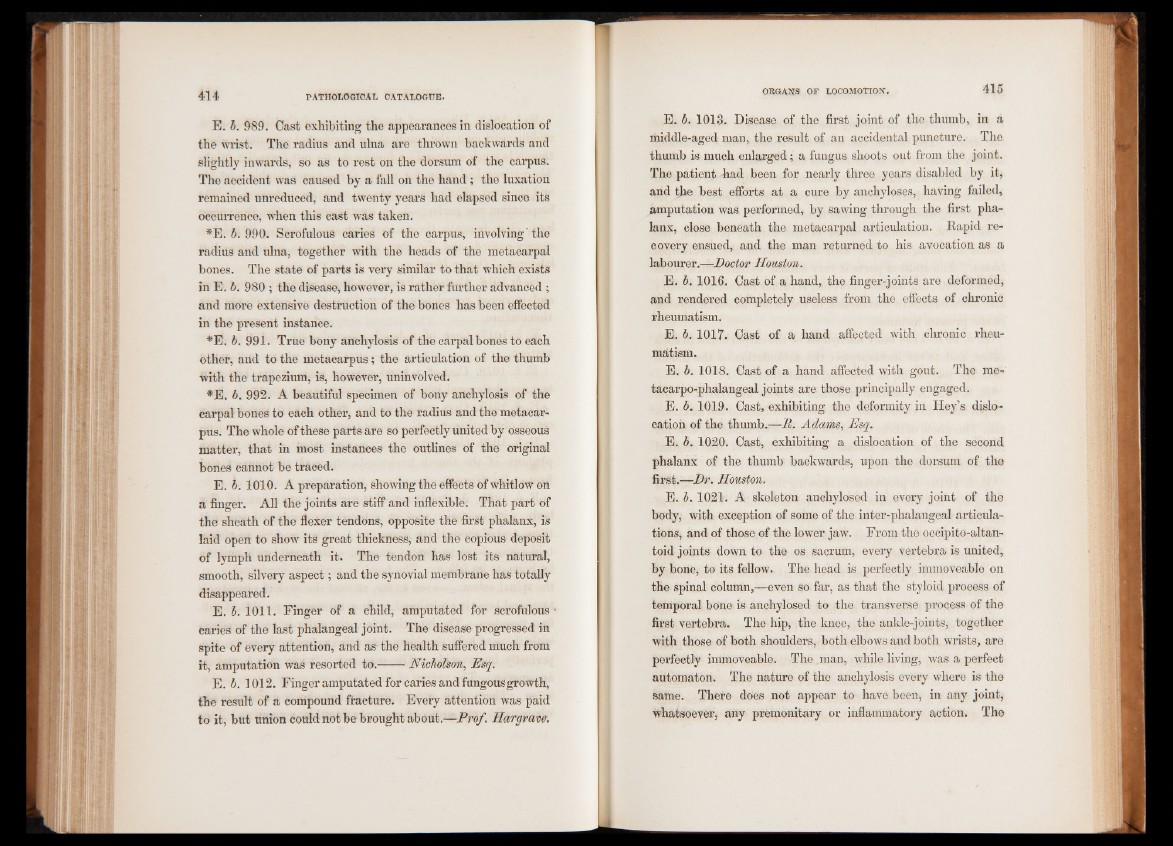
E. b. 989. Cast exhibiting the appearances in dislocation of
the wrist. The radius and ulna are thrown backwards and
slightly inwards, so as to rest on the dorsum of the carpus.
The accident was caused by a fall on the hand; the luxation
remained unreduced, and twenty years had elapsed since its
occurrence, when this cast was taken.
*E. b. 990. Scrofulous caries of the carpus, involving' the
radius and ulna, together with the heads of the metacarpal
bones. The state of parts is very similar to that which exists
in E. b. 980 ; the disease, however, is rather further advanced ;
and more extensive destruction of the bones has been effected
in the present instance.
*E. b. 991. True bony anchylosis of the carpal bones to each
other, and to the metacarpus; the articulation of the thumb
with the trapezium, is, however, uninvolved.
*E. b. 992. A beautiful specimen of bony anchylosis of the
carpal bones to each other, and to the radius and the metacarpus.
The whole of these parts are so perfectly united by osseous
matter, that in most, instances the outlines of the original
bones cannot be traced.
E. b. 1010. A preparation, showing the effects of whitlow on
a finger. All the joints are stiff and inflexible. That part of
the sheath of the flexer tendons, opposite the first phalanx, is
laid open to show its great thickness, and the copious deposit
of lymph underneath it. The tendon has lost its natural,
smooth, silvery aspect; and the synovial membrane has totally
disappeared.
E. b. 1011. Finger of a child, amputated for scrofulous •
caries of the last phalangeal joint. The disease progressed in
spite of every attention, and as the health suffered much from
it, amputation was resorted to.----- Nicholson, Esq.
E. b. 1012. Finger amputated for caries and fungousgrowth,
the result of a compound fracture. Every attention was paid
to it, but union could not be brought about.—Prof. Hargrave.
E. b. 1018. Disease of the first joint of the thumb, in a
middle-aged man, the result of an accidental puncture. The
thumb is much enlarged; a fungus shoots out from the joint.
The patient Fad been for nearly three years disabled by it,
and the best efforts at a cure by anchyloses, having failed,
amputation was performed, by sawing through the first phalanx,
close beneath the metacarpal articulation. Rapid recovery
ensued, and the man returned to his avocation as a
labourer.—-Doctor Houston.
E. b. 1016. Oast of a hand, the finger-joints are deformed,
and rendered completely useless from the effects of chronic
rheumatism.
E. b. 1017. Oast of a hand affected with chronic rheumatism.
E. b. 1018. Oast of a hand affected with gout. The me-
tacarpo-phalangeal joints are those principally engaged.
E. b. 1019. Oast, exhibiting the deformity in Key’s dislocation
of the thumb.:—R. Adams, Esq.
E. b. 1020. Oast, exhibiting a dislocation of the second
phalanx of the thumb backwards, upon the dorsum of the
first.—Dr. Houston.
E. b. 1021. A skeleton anchylosed in every joint of the
body, with exception of sonie of the inter-phalangeal articulations,
and of those of the lower jaw. From the occipito-altan-
toid joints down to the os sacrum, every vertebra is united,
by bone, to its fellow. The head is perfectly immoveable on
the spinal column,—even so far, as that the styloid process of
temporal bone is anchylosed to the transverse process of the
first vertebra. The hip, the knee, the ankle-joints, together
with those of both shoulders, both elbows and both wrists, are
perfectly immoveable. The man, while living, was a perfect
automaton. The nature of the anchylosis every where is the
same. There does not appear to have been, in any joint,
whatsoever, any premonitary or inflammatory action. The